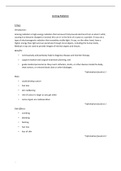Ionising Radiation
X-Rays
Introduction:
Ionising radiation is high-energy radiation that removes firmly bound electrons from an atom's orbit,
causing it to become charged or ionized; this can in in the form of a wave or a particle. X-rays are a
type of electromagnetic radiation that resembles visible light. X-rays, on the other hand, have a
higher energy than light and can penetrate through most objects, including the human body.
Medical x-rays are used to provide images of internal organs and tissues.
Benefits:
• noninvasively and painlessly help to diagnose disease and monitor therapy
• support medical and surgical treatment planning; and
• guide medical personnel as they insert catheters, stents, or other devices inside the body,
treat tumors, or remove blood clots or other blockages.
*information found at 1
Risks:
• could develop cancer
• hair loss
• skin reddening
• risk of cancer is larger as you get older
• some organs are radiosensitive
*information found at 1
Side Effects:
• vomiting
• bleeding
• fainting
• hair loss
• loss of skin
*information found at 2
``
, CT Scan
Introduction:
A CT scan combines a sequence of X-ray images taken from various angles around your body with
computer processing to create cross-sectional images (slices) of the bones, blood arteries, and soft
tissues within your body. CT scan images contain more information than standard X-rays. A CT scan
can be used for a variety of purposes, but it's especially useful for quickly examining patients who
may have internal injuries as a result of vehicle accidents or other sorts of trauma. A CT scan can
visualise almost every region of the body and is used to diagnose sickness or injury as well as plan
medical, surgical, or radiation treatment.
Benefits:
• determining when surgeries are necessary
• reducing the need for exploratory surgeries
• improving cancer diagnosis and treatment
• reducing the length of hospitalizations
• guiding treatment of common conditions such as injury, cardiac disease and stroke
• improving patient placement into appropriate areas of care, such as intensive care units
*Information found at 3
Risks:
• CT scans produce ionizing radiation, research shows that this kind of radiation may damage
your DNA and lead to cancer; the risk is still very small (1 in 2,000).
Side Effects:
• Some people are allergic to the contrast materials. Most of the time, the reaction is mild. It
can lead to itchiness or a rash. In very few cases, the dye may trigger a life-threatening
reaction.
Comparing CT Scans to X-Rays
As they are both a form of ionising radiation and both produce image scanning, both of them have
similar risks however, x-rays has more than CT which shows is more harmful; from x-rays you could
develop cancer, lose hair, skin rendering and some organs are radio sensitive. There are no risks
against CT scans.
I would utilise a CT scan to treat a patient who has been admitted to the hospital with stomach
cramping and nausea since I can see what is causing the abdominal pain, however this would not be
as successful because a CT scan could potentially induce abdominal pain. The radiologist would have
to work closely with a radiology technologist because the radiation therapy would be administered
in conjunction with the CT scan.
``




